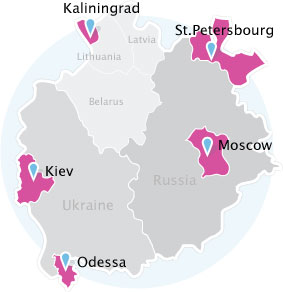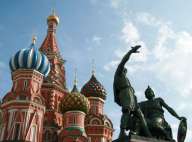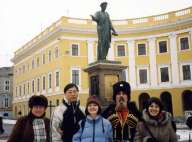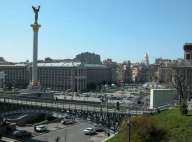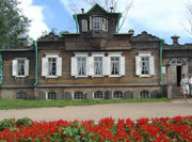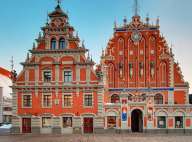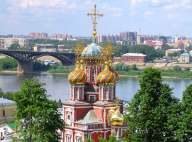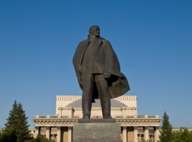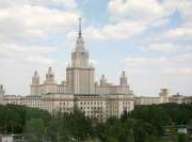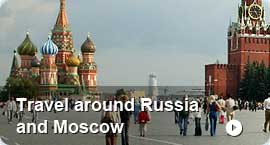Russia history
A short overview of the Russian history
You can also read our German version of this document
For more detailed information, also consult the Key facts about Russia today
The early beginning
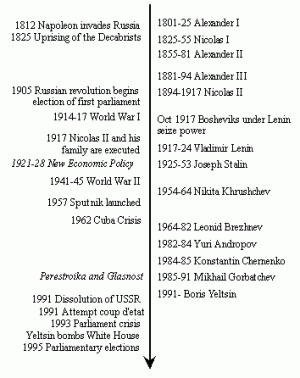 Tradition says the Viking Rurik came to Russia in C.E. 862 and founded the first Russian dynasty in Novgorod. The fact is that in the course of the 9th century, Viking tribes from Scandinavia moved southward into European Russia, tracing a path along the main waterway connecting the Baltic and Black Seas. The various tribes were united by the spread of Christianity in the 10th and 11th centuries; Vladimir the Saint was converted in 988. During the 11th century, the grand dukes of Kiev held such centralizing power as existed. In 1240, Kiev was destroyed by the Mongols, and the Russian territory was split into numerous smaller dukedoms. The Mongol Empire stretched across the Asian continent and Russia was put under the suzerainty of the Khanate of the Golden Horde. The next two centuries saw the rise of Moscow as a provincial capital and centre of the Christian Orthodox Church.
Tradition says the Viking Rurik came to Russia in C.E. 862 and founded the first Russian dynasty in Novgorod. The fact is that in the course of the 9th century, Viking tribes from Scandinavia moved southward into European Russia, tracing a path along the main waterway connecting the Baltic and Black Seas. The various tribes were united by the spread of Christianity in the 10th and 11th centuries; Vladimir the Saint was converted in 988. During the 11th century, the grand dukes of Kiev held such centralizing power as existed. In 1240, Kiev was destroyed by the Mongols, and the Russian territory was split into numerous smaller dukedoms. The Mongol Empire stretched across the Asian continent and Russia was put under the suzerainty of the Khanate of the Golden Horde. The next two centuries saw the rise of Moscow as a provincial capital and centre of the Christian Orthodox Church.
In the late 15th century, Duke Ivan III acquired Novgorod and Tver and threw off the Mongol yoke. Ivan IV, the Terrible (1533-84), first Muscovite tsar, is considered to have founded the Russian state. He crushed the power of rival princes and boyars (landowners), but Russia remained largely medieval until the reign of Peter the Great (1689-1725), grandson of the first Romanov tsar, Michael (1613-45). Peter made extensive reforms aimed at westernization and, through his defeat of Charles XII of Sweden at the Battle of Poltava in 1709, he extended Russia’s boundaries to the west. Catherine the Great (1762-96) continued Peter’s westernization program and also expanded Russian territory, acquiring the Crimea, Ukraine, and part of Poland.
During the reign of Alexander I (1801-25), Napoleon’s attempt to invade Russia was unsuccessful and his troops defeated in 1812, and new territory was gained, including Finland (1809) and Bessarabia (1812). Alexander originated the Holy Alliance, which for a time crushed Europe’s rising liberal movement. which eventually led to the Russia revolution. In the Decembrist revolt in 1825, a group of young, reformist military officers attempted to force the adoption of a constitutional monarchy in Russia by preventing the accession of Nicholas I. They failed utterly, and Nicholas became the most reactionary leader in Europe.
Alexander II (1855-81) pushed Russia’s borders to the Pacific and into central Asia. Serfdom was abolished in 1861, but heavy restrictions were imposed on the emancipated class. Revolutionary strikes, following Russia’s defeat in the war with Japan, forced Nicholas II (1894-1917) to grant a representative national body (Duma), elected by narrowly limited suffrage. It met for the first time in 1906, little influencing Nicholas in his reactionary course.
Russian revolution
World War I demonstrated tsarist corruption and inefficiency and only patriotism held the poorly equipped army together for a time. Disorders broke out in Petrograd (renamed Leningrad and now St. Petersburg) in March 1917, and defection of the Petrograd garrison launched the revolution. Nicholas II was forced to abdicate on March 15, 1917, and he and his family were killed by revolutionists on July 16, 1918. A provisional government under the successive premierships of Prince Lvov and a moderate, Alexander Kerensky, lost ground to the radical, or Bolshevik, wing of the Socialist Democratic Labor Party. On Nov. 7, 1917, the Bolshevik revolution, engineered by N. Lenin (Lenin was the pseudonym taken by Vladimir Ilich Ulyanov) and Leon Trotsky, overthrew the Kerensky government and authority was vested in a Council of People’s Commissars, with Lenin as premier. The series of events leading to the revolution was from now on as October Revolution, since Nov 7 was actually Oct 25 under the Old Russian Calendar.
The humiliating Treaty of Brest-Litovsk (March 3, 1918) concluded the war with Germany, but a brutal civil war and foreign intervention delayed Communist control of all Russia until 1920. A brief war with Poland in 1920 resulted in Russian defeat.
Emergence of the U.S.S.R.
The Union of Soviet Socialist Republics was established as a federation on Dec. 30, 1922 and the New Economic Policy started which installed the community (called soviets) as owners of land and property. The death of Lenin on Jan. 21, 1924, precipitated an intraparty struggle between Joseph Stalin, general secretary of the party, and Trotsky, who favored swifter socialization at home and fomentation of revolution abroad. Trotsky was dismissed as commissar of war in 1925 and banished from the Soviet Union in 1929. He was murdered in Mexico City on Aug. 21, 1940, by a political agent. Stalin further consolidated his power by a series of purges in the late 1930s, liquidating prominent party leaders and military officers. Stalin assumed the premiership May 6, 1941.
Soviet foreign policy, at first friendly toward Germany and antagonistic toward Britain and France and then, after Hitler’s rise to power in 1933, becoming anti-Fascist and pro-League of Nations, took an abrupt turn on Aug. 24, 1939, with the signing of a nonaggression pact with Nazi Germany. The next month, Moscow joined in the German attack on Poland, seizing territory later incorporated into the Ukrainian and Belarussian S.S.R.‘s. The war with Finland (1939-40) added territory to the Karelian S.S.R. set up March 31, 1940; the annexation of Bessarabia and Bukovina from Romania became part of the new Moldavian S.S.R. on Aug. 2, 1940; and the annexation of the Baltic republics of Estonia, Latvia, and Lithuania in June 1940 created the 14th, 15th, and 16th Soviet Republics. The illegal annexation of the Baltic republics was never recognized by the U.S. for the 51 years leading up to Soviet recognition of Estonia, Latvia, and Lithuania’s independence on Sept. 6, 1991. The Soviet-German collaboration ended abruptly with a lightning attack by Hitler on June 22, 1941, which seized 500,000 square miles of Russian territory before Soviet defenses, aided by U.S. and British arms, could halt it. The Soviet resurgence at Stalingrad from Nov. 1942 to Feb. 1943 marked the turning point in a long battle, ending in the final offensive of Jan. 1945. Then, after denouncing a 1941 nonaggression pact with Japan in April 1945, when Allied forces were nearing victory in the Pacific, the Soviet Union declared war on Japan on Aug. 8, 1945, and quickly occupied Manchuria, Karafuto, and the Kuril islands.
The U.S.S.R. built a cordon of Communist states running from Poland in the north to Albania and Bulgaria in the south, including East Germany, Czechoslovakia, Hungary, and Romania, composed of the territories Soviet troops occupied at the war’s end. With its Eastern front solidified, the Soviet Union launched a political offensive against the non-Communist West, moving first to block the Western access to Berlin. The Western powers countered with an airlift, completed unification of West Germany, and organized the defense of Western Europe in the North Atlantic Treaty Organization (NATO). Stalin died on March 6, 1953, and was succeeded the next day by G. M. Malenkov as premier.
The new power in the Kremlin was Nikita S. Khrushchev, first secretary of the party. Khrushchev formalized the Eastern European system into a Council for Mutual Economic Assistance (Comecon) and a Warsaw Pact Treaty Organization as a counterweight to NATO. The Soviet Union exploded a hydrogen bomb in 1953, developed an intercontinental ballistic missile by 1957, sent the first satellite into space (Sputnik I) in 1957, and put Yuri Gagarin in the first orbital flight around the earth in 1961. Khrushchev’s downfall stemmed from his decision to place Soviet nuclear missiles in Cuba and then, when challenged by the U.S., backing down and removing the weapons. He was also blamed for the ideological break with China after 1963. Khrushchev was forced into retirement on Oct. 15, 1964, and was replaced by Leonid I. Brezhnev as first secretary of the party and Aleksei N. Kosygin as premier.
U.S. President Jimmy Carter and the ailing Brezhnev signed the SALT II treaty in Vienna on June 18, 1979, setting ceilings on each nation’s arsenal of intercontinental ballistic missiles. The U.S. Senate refused to ratify the treaty because of the invasion of Afghanistan by Soviet troops on Dec. 27, 1979. On Nov. 10, 1982, Soviet radio and television announced the death of Leonid Brezhnev. Yuri V. Andropov, who had formerly headed the K.G.B., was chosen to succeed Brezhnev as general secretary. By mid-June 1983, Andropov had assumed all of Brezhnev’s three titles.
After months of illness, Andropov died in Feb. 1984. Konstantin U. Chernenko, a 72-year-old party stalwart who had been close to Brezhnev, succeeded him as general secretary and, by mid-April, had also assumed the title of president. In the months following Chernenko’s assumption of power, the Kremlin took on a hostile mood toward the West of a kind rarely seen since the height of the cold war 30 years before. Led by Moscow, all the Soviet bloc countries except Romania boycotted the 1984 Summer Olympic Games in Los Angeles for the U.S.-led boycott of the 1980 Moscow Games, in the view of most observers. After 13 months in office, Chernenko died on March 10, 1985. He had been ill much of the time and left only a minor imprint on Soviet history.
Chosen to succeed him as Soviet leader was Mikhail S. Gorbachev, at 54 the youngest man to take charge of the Soviet Union since Stalin. Under Gorbachev, the Soviet Union began its long-awaited shift to a new generation of leadership. Unlike his immediate predecessors, Gorbachev did not also assume the title of president but wielded power from the post of party general secretary. In a surprise move, Gorbachev elevated Andrei Gromyko, 75, for 28 years the Soviet Union’s stony-faced foreign minister, to the largely ceremonial post of president. He installed a younger man with no experience in foreign affairs, Eduard Shevardnadze, 57, as foreign minister. The Soviet Union took much criticism in early 1986 over the April 24 meltdown at the Chernobyl nuclear plant and its reluctance to give out any information on the accident.
In June 1987, Gorbachev obtained the support of the Central Committee for proposals that would loosen some government controls over the economy and in June 1988, an unusually open party conference approved several resolutions for changes in the structure of the Soviet system. These included a shift of some power from the party to local soviets, and a ten-year limit on the terms of elected government and party officials. Gorbachev was elected president in 1989. The elections to the Congress were the first competitive elections in the Soviet Union since 1917. Dissident candidates won a surprisingly large minority although pro-Government deputies maintained a strong lock on the Supreme Soviet.
Dissolution of the U.S.S.R.
The possible beginning of the fragmentation of the Communist Party and the Soviet era took place when Boris Yeltsin, leader of the Russian S.S.R. who urged faster reform, left the Communist Party along with other radicals. In March 1991, the Soviet people were asked to vote on a referendum on national unity engineered by President Gorbachev. The resultant victory for the federal government was tempered by the separate approval in Russia for the creation of a popularly elected presidency of the Russian republics. The bitter election contest for the Russian presidency, principally between Yeltsin and a Communist loyalist, resulted in a major victory for Yeltsin. He took the oath of office for the new position on July 10, 1991.
 Reversing his relative hard-line position, Gorbachev together with leaders of nine Soviet republics signed an accord called the Union Treaty, which was meant to preserve the unity of the nation. In exchange the federal government would have turned over control of industrial and natural resources to the individual republics. An attempted coup d‘йtat took place on August 19, 1991, orchestrated by a group of eight senior officials calling itself the State Committee on the State of Emergency. Boris Yeltsin, barricaded in the Russian parliament building, defiantly called for a general strike. The next day huge crowds demonstrated in Leningrad, and Yeltsin supporters fortified barricades surrounding the parliament building. On August 21 the coup committee disbanded, and at least some of its members attempted to flee Moscow. The Soviet parliament formally reinstated Gorbachev as president. Two days later he resigned from his position as General-Secretary of the Communist Party and recommended that its Central Committee be disbanded. On August 29 the parliament approved the suspension of all Communist Party activities pending an investigation of its role in the failed coup. At the time of the attempted coup, the republic’s President Boris Yeltsin was the most popular political figure in the lands comprising the former Soviet Union. A leading reformer, he became the first directly elected leader in Russian history and received 60% of the vote for president of the Russian Republic.
Reversing his relative hard-line position, Gorbachev together with leaders of nine Soviet republics signed an accord called the Union Treaty, which was meant to preserve the unity of the nation. In exchange the federal government would have turned over control of industrial and natural resources to the individual republics. An attempted coup d‘йtat took place on August 19, 1991, orchestrated by a group of eight senior officials calling itself the State Committee on the State of Emergency. Boris Yeltsin, barricaded in the Russian parliament building, defiantly called for a general strike. The next day huge crowds demonstrated in Leningrad, and Yeltsin supporters fortified barricades surrounding the parliament building. On August 21 the coup committee disbanded, and at least some of its members attempted to flee Moscow. The Soviet parliament formally reinstated Gorbachev as president. Two days later he resigned from his position as General-Secretary of the Communist Party and recommended that its Central Committee be disbanded. On August 29 the parliament approved the suspension of all Communist Party activities pending an investigation of its role in the failed coup. At the time of the attempted coup, the republic’s President Boris Yeltsin was the most popular political figure in the lands comprising the former Soviet Union. A leading reformer, he became the first directly elected leader in Russian history and received 60% of the vote for president of the Russian Republic.
Yeltsin championed the cause for national reconstruction and the adoption of a Union Treaty with the other republics to create a free-market economic association. On Dec. 12, 1991, the Russian parliament ratified Yeltsin’s plea to establish a new commonwealth of independent nations open to all former members of the Soviet Union. The new union was created with the governments of Ukraine and Belarus who along with Russia were the three original cofounders of the Soviet Union in 1922. After the end of the Soviet Union, Russia and ten other Soviet republics joined in a Commonwealth of Independent States on Dec. 21, 1991.
 At the start of 1992, Russia embarked on a series of dramatic economic reforms, including the freeing of prices on most goods, which led to an immediate downturn. A national referendum on confidence in Yeltsin and his economic program took place in April 1993. To the surprise of many, the president and his shock-therapy program won by a resounding margin. Yeltsin convened a constitutional conference in June, which adopted a draft constitution in July. In September, Yeltsin dissolved the legislative bodies left over from the Soviet era. The impasse between the executive and the legislature resulted in an armed conflict on Oct. 3 with vice-president Rutskoi opposing the orders of Yeltsin and barricading the White House. Yeltsin prevailed largely through the support of the military which bombed the White House and arrested the Rutskoi and the opposing parliament members. The constitutional referendum on Dec. 12 was a victory for Yeltsin, but the parliamentary election on the same day saw the rise of the extreme nationalist Vladimir Zhirinovsky, with Western-oriented parties performing relatively poorly.
At the start of 1992, Russia embarked on a series of dramatic economic reforms, including the freeing of prices on most goods, which led to an immediate downturn. A national referendum on confidence in Yeltsin and his economic program took place in April 1993. To the surprise of many, the president and his shock-therapy program won by a resounding margin. Yeltsin convened a constitutional conference in June, which adopted a draft constitution in July. In September, Yeltsin dissolved the legislative bodies left over from the Soviet era. The impasse between the executive and the legislature resulted in an armed conflict on Oct. 3 with vice-president Rutskoi opposing the orders of Yeltsin and barricading the White House. Yeltsin prevailed largely through the support of the military which bombed the White House and arrested the Rutskoi and the opposing parliament members. The constitutional referendum on Dec. 12 was a victory for Yeltsin, but the parliamentary election on the same day saw the rise of the extreme nationalist Vladimir Zhirinovsky, with Western-oriented parties performing relatively poorly.
The southern republic of Chechnya’s president accelerated his region’s drive for independence in 1994. In December, Russian troops closed the borders and sought to squelch the independence drive. The Russian military forces met firm and costly resistance. Shortly before the scheduled presidential election of June 1996, a ceasefire was arranged in Chechnya. Yeltsin started the year with slim chances for reelection. But bolstered by favorable media attention, fear of a Communist resurgence, and vigorous campaigning he won the second round of voting in July against a Communist opponent. In May 1997, the two-year war formally ended with the signing of a peace treaty that adroitly avoided the issue of Chechen independence.
Yeltsin bounded back into the political fray in March 1997 after eight months’ absence caused by sickness. His first action was to reshuffle the Cabinet to include new ministers with strong reform credentials. The young reformers announced plans to overhaul taxation, housing, and welfare; restore central control over headstrong regional leaders; and curb the power of Russia’s monopolies (natural gas, electricity, and railways). These plans for reform, however, went awry.
In March 1998 Yeltsin dismissed his entire government and replaced Prime Minister Viktor Chernomyrdin with the young and little known fuel and energy minister Sergey Kiriyenko. On August 28, 1998, amid the Russian stock market’s free fall, the Russian government halted trading of the ruble on international currency markets. This financial crisis led to a long-term economic downturn and to political upheaval. President Boris Yeltsin then sacked Prime Minister Kiriyenko and reappointed Chernomyrdin. The Duma rejected Chernomyrdin, and on Sept. 11 elected foreign minister Yevgeny Primakov as prime minister. The repercussions of Russia’s financial emergency were felt throughout the world.
 Impatient with Yeltsin’s chronic illnesses and increasingly erratic behavior, the Duma attempted to impeach him in May 1999 on five charges: provoking the 1991 fall of the Soviet Union, using force to dissolve the parliament in 1993, starting the ill-conceived 1994-96 war in Chechnya, ruining the nation’s military, and impoverishing the Russian people through ruinous economic policies – the charge regarding Chechnya was considered the only one with a chance of approval. But the impeachment motion was quickly quashed and soon Yeltsin was on the ascendancy again. In keeping with his capricious style, Boris Yeltsin dismissed Prime Minister Yevgeny Primakov and replaced him with Interior Minister Sergey Stepashin, who was confirmed by the Duma May 19. On August 9, 1999 Borits Yeltsin announced Vladimir Putin, former head of KGB, as new Prime Minister. The Chechnya conflict surged again after the government blamed Chechen terrorist for bombings in Moscow that had killed hundreds of people. On the last day of the century, Dec. 31, 1999, Boris Jelzin announces his resignation. Vladimir Putin is his successor and is elected president of Russia on March 26, 2000. Ever since, the conflict with Chechen rebels and terrorists has continued and Russia’s military force have increased their presence in the region to enforce stability. On March 2, 2008, Dmitry Medvedev, a protege of Putin, is elected President with about 70% of the votes. Vladimir Putin assumes the role of Prime Minister, keeping control of the government.
Impatient with Yeltsin’s chronic illnesses and increasingly erratic behavior, the Duma attempted to impeach him in May 1999 on five charges: provoking the 1991 fall of the Soviet Union, using force to dissolve the parliament in 1993, starting the ill-conceived 1994-96 war in Chechnya, ruining the nation’s military, and impoverishing the Russian people through ruinous economic policies – the charge regarding Chechnya was considered the only one with a chance of approval. But the impeachment motion was quickly quashed and soon Yeltsin was on the ascendancy again. In keeping with his capricious style, Boris Yeltsin dismissed Prime Minister Yevgeny Primakov and replaced him with Interior Minister Sergey Stepashin, who was confirmed by the Duma May 19. On August 9, 1999 Borits Yeltsin announced Vladimir Putin, former head of KGB, as new Prime Minister. The Chechnya conflict surged again after the government blamed Chechen terrorist for bombings in Moscow that had killed hundreds of people. On the last day of the century, Dec. 31, 1999, Boris Jelzin announces his resignation. Vladimir Putin is his successor and is elected president of Russia on March 26, 2000. Ever since, the conflict with Chechen rebels and terrorists has continued and Russia’s military force have increased their presence in the region to enforce stability. On March 2, 2008, Dmitry Medvedev, a protege of Putin, is elected President with about 70% of the votes. Vladimir Putin assumes the role of Prime Minister, keeping control of the government.
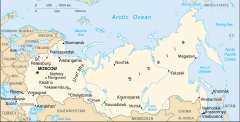 For more detailed information, also consult the CIA Factsbook of Russia.
For more detailed information, also consult the CIA Factsbook of Russia.
Key facts about Russia today
Economic summary
Russia has vast mineral resources include oil and natural gas, coal, iron, zinc, lead, nickel, aluminum, molybdenum, gold, platinum, and other nonferrous metals. GDP per capita (USD 4000) has fallen by about 40 % since 1992. Nevertheless, the economy has started to grow again since 1999 with annual growth rates of 4-9%. Current avg. monthly salaries are USD 200 with large regional differences (in Moscow > USD 500). The economic outloook is very good: direct net investments into the country have been positive, and the Russian government is producing healthy surpluses, mainly due to high oil prices.

